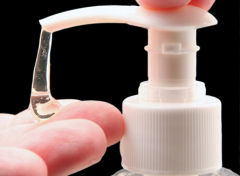A new source of dioxins: Clean hands
The contaminants that form are novel and their risks unknown
Manufacturers have been adding the germ fighter triclosan to soaps, hand washes, and a range of other products for years. But here’s a dirty little secret: Once it washes down the drain, that triclosan can spawn dioxins.

Dioxins come in 75 different flavors, distinguished by how many chlorine atoms dangle from each and where those atoms have attached (their locations indicated by the numbers in the front part of a dioxin’s name). The most toxic is 2,3,7,8-tetrachlorodibenzo-p-dioxin, or TCDD. Some related kin bearing four to eight chlorines are also toxic, just less so.
Triclosan’s dioxin progeny belong to this infamous family, but aren’t the ones that have typically tainted the environment. And, before you ask: No one knows how toxic triclosan’s dioxins are. Few investigations have been conducted because chemists considered them arcane and too rare to pose a threat.
Patented in 1964, triclosan quickly found use in medical supplies. By 1987, manufacturers were adding it to liquid hand soaps for the consumer market. Within a little more than a dozen years, three-quarters of all such liquid hand soaps would contain the chemical. And as these soaps were used, triclosan washed down residential drains along with chlorinated tap water, forming super-chlorinated triclosan.
In wastewater treatment plants, the bonus chlorine atom or two that tap water had added to the molecule tends to be stripped off, notes William Arnold, an environmental engineer at the University of Minnesota in Minneapolis. But in the finishing stage at those treatment plants, most water gets one last chlorine-disinfection step, which “will re-chlorinate the triclosan,” he says, before the water is released out into rivers.
Arnold’s group and others have demonstrated in the lab that that in the presence of sunlight, the super-chlorinated triclosan can undergo transformations that beget a series of dioxins. They include 2,8-dichlorodibenzo-p-dioxin, 2,3,7- and 1,2,8-trichlorodibenzo-p-dioxin, and 1,2,3,8-tetrachlorodibenzo-p-dioxin.
The genesis of these compounds isn’t just some laboratory curiosity. Triclosan’s odd dioxins also develop in the environment — big time, Arnold’s group reported May 18 online, ahead of print, in Environmental Science & Technology.
Lake fallout
The researchers collected roughly 80-centimeter-deep cores of sediment from a lake downstream of several wastewater treatment plants serving Minneapolis and St. Paul. Like tree rings, sediment layers record the deposition of pollutants as they settle out, with deeper contaminants reflecting fallout from increasingly distant points in time.
Plenty of TCDD and its related kin sat at the bottom of the cores reflecting deposition from the 1940s, but there were none of the unusual dioxins associated with the phototransformation of triclosan. As Arnold’s group assayed these cores from the bottom up, concentrations of the conventional dioxins gradually diminished — and quantities of triclosan’s dioxins climbed.
“It looks like it’s the 1970s when we first really got a hit on the [triclosan] dioxins,” Arnold says. Meanwhile, he adds, TCDD and its kin “appear to have peaked in the mid-70s. Then incineration technologies improved and they’ve been decreasing ever since.”
In the sediment’s topmost strata, triclosan-related byproducts now account for roughly one-third of all dioxins present. Which indicates, the researchers conclude, that at least in the aquatic world these compounds “represent a previously unrecognized and increasingly important source of di-, tri-, and tetrachlorinated dibenzo-p-dioxins.”
To investigate how broadly they’re littering the environment, “We’re going to broaden our survey, looking in about half a dozen lakes in Minnesota,” Arnold says — and probe to see whether contaminants that are structurally similar to triclosan might also be generating novel dioxins.
“It’s always of concern when we’re generating compounds that appear to be stable in the environment and increasing in concentration,” Arnold says — especially when any risk they might pose remains unclear. That’s why he describes the triclosan-dioxin trend that his team unearthed as “disconcerting.”
Oh, and intact triclosan may pose its own environmental risks, another study finds. It exposed male mosquitofish that had come from relatively clean water to triclosan for a month. Concentrations were high, about 100 times what is usually found in water. The treatment induced the guys to produce notable amounts of egg-yolk protein — something only females are supposed to do. Sperm production in these fish also took a big hit, falling by a third when compared to untreated males.
Bottom line: These data indicate the pollutant is “weakly estrogenic” and “imply that triclosan has the potential to act as an endocrine-disrupting agent in aquatic organisms,” according to Robert Angus of the University of Alabama at Birmingham and Samiksha Raut of Dalton State College in Georgia. They describe their findings in the June Environmental Toxicology and Chemistry.






